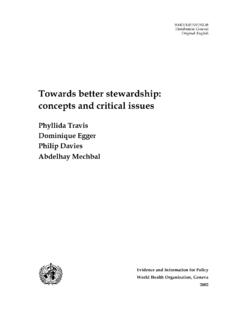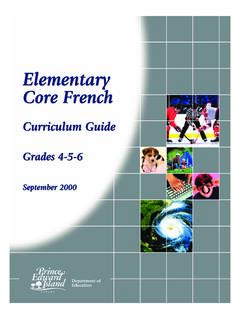Transcription of CICV Circular Economy Literature Review Final …
1 This report was prepared by the International Reference Centre for the Life Cycle of Products, Processes and Services (CIRAIG). Founded in 2001, the CIRAIG is a life cycle centre of expertise that is internationally recognized for its work and initiatives rooted in a strong scientific basis and close to fifteen years applied experience. The CIRAIG supports corporations, governments, organizations and consumers in their sustainable development plans driven by life cycle thinking. The CIRAIG has developed a recognized expertise in life cycle tools including Life Cycle Assessment (LCA) and Social Life Cycle Assessment (SLCA). Completing this expertise, its research projects also cover Life Cycle Costing (LCC) and other tools such as carbon and water footprinting.
2 CIRAIG s activities include applied research projects that span several activity sectors including energy, aerospace, agri- food, waste management, forestry and pulp and paper, mining and metals, chemical products, telecommunications, financial services, urban infrastructure management, transport as well as green product design. A joint initiative by Polytechnique Montr al and ESG UQAM, the CIRAIG brings together engineering and social sciences and has developed a research program driven by multidisciplinarity. WARNING With the exception of complete documents produced by the CIRAIG, Polytechnique Montr al and/or ESG UQAM, such as this report, a written consent by a duly authorized representative of CIRAIG, Polytechnique Montr al and/or ESG- UQAM must be obtained prior to any use of the name CIRAIG, Polytechnique Montr al and/or ESG- UQAM in a public disclosure related to this project and its results.
3 3333 Queen- Mary, Suite 310 Montr al (Qu bec) Canada, H3V 1A2 Polytechnique Montr al D partement de g nie chimique 2900, douard- Montpetit 6079, Succ. Centre- ville Montr al (Qu bec), Canada, H3C 3A7 Universit du Qu bec Montr al (UQ M) cole des sciences de la gestion (ESG) 315 Rue Sainte- Catherine E 8888 succ. Centre- ville Montr al (Qu bec), Canada, H3C 3P8 ISBN 978- 2- 9815420- 0- 7 (PDF) Legal deposit: Biblioth que et Archives nationales du Qu bec (BAnQ), August 2015 Prepared for: The Circular Economy Working Group of the International Life Cycle Chair (ILC Chair), a CIRAIG research unit: ArcelorMittal Bombardier A ronautique LVMH Michelin Mouvement des caisses Desjardins Nestl RECYC- QU BEC Solvay TOTAL Umicore Veolia LIFE CYCLE CHAIR PARTNERS CIRAIG Final Report Page iv Circular Circular Economy .
4 A CRITICAL Literature Review OF CONCEPTS October 2015 Project team Luce Beaulieu Analyst Gabrielle van Durme Analyst Marie- Luc Arpin PhD Student, ESG- UQ M Scientific direction Jean- Pierre Rev ret Professor, ESG- UQ M Co- chairholder, ILC Chair Manuele Margni Professor, Polytechnique Montr al Co- chairholder, ILC Chair Project management Sophie Fallaha Director of industrial relations, ILC Chair C Circular Economy Working Group CIRAIG October 2015 Circular Economy : A CRITICAL Literature Review OF CONCEPTS Page v Summary The concept of a Circular Economy has gained much traction in the global business community in the last 5 years.
5 This holistic concept is supported by many stakeholders, but is mostly championed by the Ellen McArthur Foundation, who depicts it as a solution to sustainability and thriveability for both business and planet. The concept is usually presented as an alternative to the linear Economy , which according to the Ellen MacArthur Foundation, is synonymous with a take- make- waste approach to goods and services production. A Circular Economy is systemic by design, close- looped, restorative, waste- free, based on effectiveness and runs on renewable energy. Circular Economy supporters portray it as an exciting and whole new way of transforming the Economy into a regenerative economic system that will, as a baseline, exist within planetary limits.
6 This attractive proposition is a social construct which grew out of the sediment layered by many different concepts that have been in existence for some time now. Thus, this critical Literature Review aims at presenting: 1) a general and conceptual portrait of Circular Economy as well as its underlying key concepts; 2) an explanation of Circular Economy s main tenets (from definition to implementation); and 3) a positioning and mapping of the various pre- defined concepts. Various analyses and key takeaways are provided all through the Review . Circular Economy associated key concepts The list of defined concepts covers a large area of theoretical strands from which Circular Economy is derived.
7 These ten concepts have all provided conceptual building blocks to understanding Circular Economy . They are presented in order of conceptual scale (from more to less encompassing): Sustainable Development Ecological Transition Green Economy Functional Economy Life Cycle Thinking Cradle- to- cradle thinking Shared Value Industrial Ecology Extended Producer Responsibility Ecodesign Sustainable Development is a polysemic and comprehensive concept that attempts to reconcile and fuse together three dimensions of development: economic, environmental and social. It ties in with Circular Economy through the economic and environmental dimensions, as well as through Corporate Social Responsibility, business entryway into Sustainable Development.
8 Ecological Transition is a polymorph concept, which encompasses theory, discourse and implementation and is mostly used by the French government to describe a multi- stakeholder process meant to direct society towards an economic development compatible with planetary limits. Green Economy is a concept that proposes economic solutions to mostly environmental issues through large, multi- partite policy proposals emanating from the United Nations and trickling through national governments and NGOs. The Functional Economy (also known as Performance Economy ) is one of the main DNA strands (along with Cradle- to- cradle and Industrial Ecology) of Circular Economy .
9 In order for business to decouple growth from resources consumption, new business models based on selling performance (or service) rather than goods, and on CIRAIG Final Report Page vi Circular Circular Economy : A CRITICAL Literature Review OF CONCEPTS October 2015 retained ownership, must be adopted. This general idea can then spur innovation and create incentives to close production and consumption loops. Life Cycle Thinking (LCT) is closely tied with Life Cycle Assessment (LCA) and Life Cycle Management (LCM). Its main goal is to reduce environmental impacts through an ISO landmarked, eco- efficiency based methodology which looks at each step of the product, process or service s life cycle, in order to design or redesign these with less embedded impacts.
10 Cradle- to- Cradle Thinking is a concept that was developed and commercialized by Michael Braungart and William McDonough and is perhaps the main conceptual pillar of Circular Economy . Cradle- to- cradle champions eco- effectiveness (and dismisses eco- efficiency) through an approach based on cycling technical and biological nutrients in order to achieve healthy material metabolisms. Shared Value is a management approach that was developed by strategy authorities Michael Porter and Mark Kramer in order to reconcile capitalism with societal needs. The framework calls for business to create value by identifying and addressing social needs through new products and markets, redefined value chains and the creation of community development clusters.

